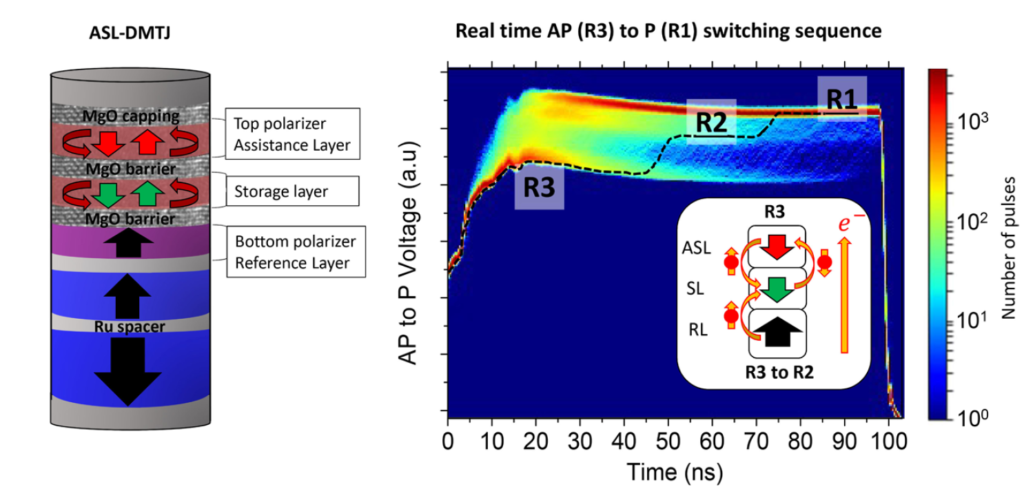Magnetic Random Access Memory recently started to be commercialized by all main microelectronics factories. In MRAM, the information is coded via parallel or antiparallel magnetic configurations to represent ones and zeroes. The technology is intrinsically nonvolatile, meaning it can keep information without being electrically powered. However, nonvolatility often comes with a trade-off between the information retention and the ease of writing. A higher energy barrier between parallel and anti-parallel states results in more stability and retention but more difficult switching and writing. In this work, we succeeded to improve both aspects by adding to the widely used magnetic stack and extra assistance layer.
Left : Memory cell with the three main magnetic layers highlighted : Reference layer (Ref), storage layer (SL) and Assistance layer (ASL).
Right: Real time measurement of the device resistance during write pulse showing the initial state (characterized by resistance R3), an intermediate state in which REF and ASL are magnetized .
A Spin Transfer torque MRAM cell consists of a magnetic tunnel junction which essentially comprises two magnetic layers separated by a tunnel barrier. One of this layer (the Reference layer) has a fixed magnetization whereas the magnetization of the other (the Storage layer : SL) can be switched to be set either parallel or antiparallel to that of the Reference layer (REF). This magnetization switching is achieved by sending pulses of current through the tunnel junction, taking advantage of the magnetic torque which results from the exchange interactions between the spin-polarized tunneling electrons and those responsible for the Storage layer magnetization (so-called spin-transfer torque). In conventional STT-MRAM, the SL magnetization is only submitted to the spin transfer torque originating from the REF. In the present study, a third magnetic layer called “assistance layer” (ASL) was added above the SL (see Figure) to create a second spin-transfer torque contribution on the free layer. The ASL magnetization can also be switched due to the spin transfer torque from the SL. The properties of this ASL have been carefully tuned so that during the write pulse, the spin transfer torque from the ASL on the SL magnetization adds up with that from the Reference layer to enable switching of the SL magnetization at lower write current. Besides, the interactions between the storage layer and ASL were adjusted so that the ASL magnetization always ends up parallel to that of the storage layer in standby thus increasing the thermal stability of the SL magnetization. As a result, both the memory retention and writability were improved.
The team conducted real time measurements of the device resistance and demonstrated that the layers switch dynamically as expected. They aim to improve the constituent materials in the future to further improve the memory performance.
Teams: MRAM, Theory and Simulation, Materials Growth, Nanofabrication, Instrumentation
Funding: ERC MAGICAL n°669204
Further reading: Real-time investigation of double magnetic tunnel junction with a switchable Assistance layer for high efficiency STT-MRAM, Daniel Sanchez Hazen, Bruno Miguel da Silva Teixeira, David Salomoni, Stephane Auffret, Laurent Vila, Ricardo C. Sousa, Ioan Lucian Prejbeanu, Liliana D. Buda-Prejbeanu, and Bernard Dieny, APL Materials 10, 031104 (2022).
Contact: Bernard DIENY

